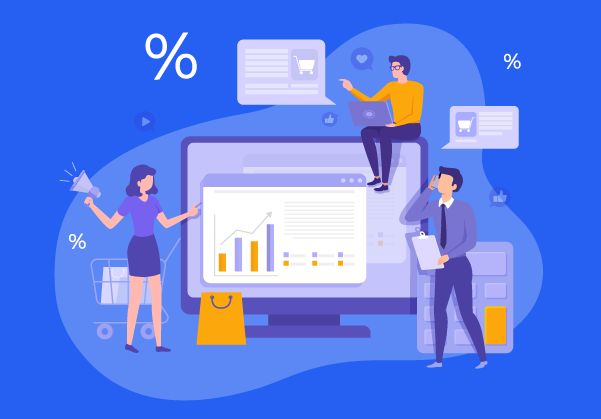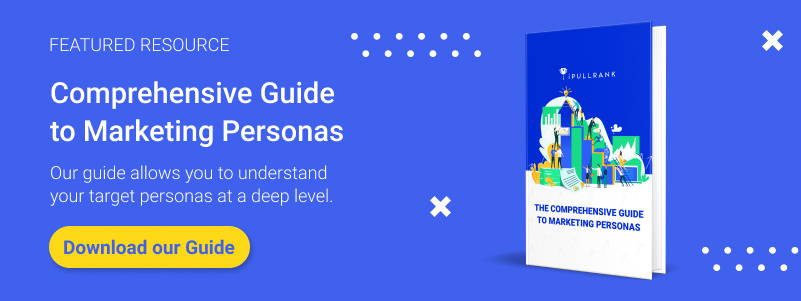Shopping has changed.
Digital sales teams (via email, phone, or live chat) used to have a monopoly on information. If customers wanted an in-depth look at a particular product or brand, they needed to go through a salesperson to get that information.
Not anymore.
According to the United States Ecommerce Country Report, 88% of consumers research products online before buying. Google data states that 53% of shoppers always research before buying to ensure that they’re making the best possible choice. That number continues to grow. This change has shifted the balance of power from brands to consumers.
It’s changed the buyer’s journey.
Successful brands need to customize their eCommerce content strategy, harmonizing with consumer research trends and the buyer’s journey.
Here’s what we’ll cover today:
- What is the ecommerce buyer’s journey?
- Why you should plan your content strategy around personas in the buyer’s journey
- The benefits of building your strategy around personas
- The risks of not using personas in your ecommerce content strategy
- How to map an ecommerce customer journey for multiple personas
- Why you need to revisit your customer journey maps and content periodically
- How to allocate the appropriate time and resources to each persona and stage in the ecommerce buyer’s journey
- How an agency can help build out your content strategy using personas
What is the ecommerce buyer’s journey?
The buyer’s journey is the four-step process almost every customer goes through when shopping online. Each step comes with its own set of requirements and expectations. Here are the steps in the buyer’s journey:
- Awareness: Your buyer realizes they have a desire, problem, or goal — why are the muscles in my back sore in the morning? Your buyer’s awareness is oriented around specific desires, goals, expectations, or pain points at this stage.
- Research: Here’s where consumers deviate from tradition; past customers brought their problems to a brand. The salesperson identified a solution and, depending on how well they did, were rewarded with a sale. That’s no longer the case; research from CSO Insights shows 70% of buyers define their needs and 44% identify specific solutions before contacting a seller. Buyer queries can move from sore muscle relief to heat wraps and pain patches for the lower back.

Data from Google backs this up. In a recent survey, 55% of buyers search for a product on Google, then learn more by going to YouTube before purchasing. Approximately 90% of shoppers surveyed say they’ve discovered new products and brands via YouTube.
- Consideration: At this point, your buyers have an idea of their problem. They’ve already clarified their needs and identified a solution; they analyze reviews, ingredients, pricing, shipping details, and specs. They’ve identified a list of products and ecommerce brands that have what they’re looking for. Research shows buyers will visit a minimum of three websites before making their decision.
This is the problem. In the past, brands could set the criteria for a solution via their sales and marketing teams. Today these criteria are defined by buyers themselves. Here’s the good news. Customers are eager to work with brands that are willing to earn their trust via education and information. Buyers may have a specific brand in mind, i.e., IcyHot heat wraps, or a more generic product, i.e., best heat wraps for the lower back.
- Purchase: In this final stage, customers have confirmed their solution. They’ve identified the ecommerce provider with the best product, price, process, and terms. They’ve narrowed their decision to a specific company.
They’re ready to make their decision to purchase. If you’ve mapped your content strategy to the buyer’s journey, you’ve already provided customers with the education and information they need.
- Post-purchase: Customers may have various concerns on their minds, e.g., how do I track my order? How do I return my items or report a problem with my order? How can I update my order? In this stage, customers will need post-purchase assistance and support.
Here’s the interesting part.
As customers become more familiar with your brand, the buyer’s journey is shorter. Think about your own experience here. How much time do you need to purchase the usual products on Amazon?
See what I mean?
Does this mean that familiarity will always reduce time spent progressing through the buyer’s journey?
It depends.
There are obvious exceptions; for example, the more expensive the product, the more time spent in the interest and consideration stages.
Why you should plan your content strategy around personas in the buyer’s journey
It all comes down to loss aversion.
Remember the question I asked in my previous post? Are you creating content for buyers or your audience? It’s easy (and convenient) to assume that these are the same people.
Don’t forget.
If you’re going to use personas…
- The Audience persona is typically someone looking to consume content for education or entertainment. These people are not actively looking to purchase a good or service.
- The Buyer persona may also be looking to consume content, but only as a means to make the specific transaction to support their needs.
The reason stands out, doesn’t it?
If your eCommerce content strategy is oriented around audience personas, sales and revenue will be an uphill battle. If your content is the tiebreaker that woos buyers to your brand, you’ll need to lead with the right persona.
Why is it so important to build your content strategy around the right personas? It ensures that you achieve and maintain the product/market fit you need to grow.
This means you:
- Have matching values: Some customers look for a socially or politically conscious brand that sells no-harm products. Others are looking for leadership and influencers to display markers of the same lifestyle and purpose. Buyers expect you to take a stand on issues that matter to them and align with their values.
- Understand their experience and expectations: You know the desires, goals, and expectations customers have. You know what they want from your business, your customer support teams, and the products you sell. You’re aware of your buyer’s deeply held desires.
- Are aware of their objections and concerns: Past experiences, inexperience, or closely-held perceptions form the basis of their objections. These three areas inform a buyer’s sensitivity to risk. If you understand this, you have the knowledge you need to defuse these objections and reduce the risk to your customer.
- Know where they spend their time: You’re aware of the influencers, brands, products, and services they use. You know where (and how) your buyers spend their time, whether it’s online or offline.
- Know the demographics: You know that this information informs everything, from the language you use in your marketing, to the pricing range on products, to disposable income, which products to sell, and the age and size of their household.
- Understand their pain points: You know what your buyer’s problems are, why it’s a problem for them, and the consequences of leaving that problem unsolved. This means you also understand the solutions available to customers and the outcome of each option.
The deeper your understanding of the buyer’s journey, your personas, and the market, the easier it is to find and maintain product/market fit.
What are the benefits of building your content strategy around personas?
It seems like an obvious idea.
If you build your content strategy around your buyer personas, you’ll know which content matters most to your audience and how to deliver it.
That’s true.
But there are subtle benefits to personas; when you use personas to guide your content marketing strategy, you can:
- Gain precise control over your targeting and messaging: A persona-driven approach means you can quickly change, retool, or update content strategy based on your persona. If you’re Lowes and you’re selling power drills to your general contractor persona, you can easily create content for your DIY homeowner persona, someone who feels lost when it comes to power tools.
- Avoid alienating segments of your list: A 2019 survey found that 90 of U.S. consumers hate personally irrelevant messages from companies. It’s jarring when customers receive offers for products they either already own or don’t want. Sharing the wrong user stories (i.e., sharing a parenting story with bachelors), attempting to build rapport with mismatched values, these are all great ways to alienate your audience. And they’re all easy to avoid if your content strategy is persona-driven.
- Identify negative personas: These are the people you do not want. This eliminates waste since you know who these people are, you have a clear idea of who and what you’ll need to avoid in your sales and marketing efforts. It’s a simple way to decrease customer acquisition costs and increase return on ad spend (ROAS).
- Develop content buckets: You’re able to identify the needs of your audience — this means you’re able to create specialized, regular, or ad hoc content that serves the needs of your specific audience. There’s no guesswork, no wondering if you’ve covered all of your bases.
- Improve ad targeting: If you know the personas you’re targeting and the content buckets you’re pursuing, you’ll gain a clear idea of how much you should spend and where you should spend it. If you receive a 37% conversion lift with smaller platforms like BuySellAds over large platforms Facebook, content placement seems like a no-brainer. Segmentation via buyer personas and content buckets makes it easier to direct your traffic to the right place.
- Measure performance by persona: You’re able to test out various content types on specific personas. This is incredibly beneficial because it enables you to test and verify which personas perform best. Measurement also allows you to iterate. You’re able to test, tweak, and update your personas as new data comes in. Finally, you’re able to gauge performance across a variety of other metrics, revenue by segment, engagement levels, profit margins by segment, etc.
These benefits depend on the upfront work you do to develop your buyer personas.
What if you didn’t?
What if you decided against using personas in your eCommerce strategy? You’d miss out on all of the benefits above. In fact, these benefits would begin to work against you over time.
Your acquisition costs would increase, especially if you didn’t have data on your negative personas. Your content would attract certain audiences segments but repel others. Your content marketing strategy would be harder to measure, and it would be harder to identify your best converting content.
If personas are neglected, these benefits quickly become drawbacks.
Let’s say you’ve already done the work.
What’s next?
How to map an ecommerce customer journey for multiple personas
Customers are the foundation of all marketing. Targeting them with your content begins with understanding who they are and what they want.
How do you do that?
You start by collecting as much data on your customers as you can find. To quote Mike King, “what you’re doing is collecting data, segmenting it, and telling a story about that segment.” So first things first, you’ll need to collect data on your customers.
Qualitative options include:
- Affinity mapping
- Focus groups
- Customer interviews
- Ethnographic data
Quantitative options include:
- Multiple-choice surveys
- Analytics
- Market segmentation tools (ComScore)
- User profiles
- Internal data (calls, sales, returns, etc.)
- Publicly available studies.
For a detailed breakdown of buyer personas, you can read Mike King’s comprehensive guide here. Remember the data I mentioned earlier?
Your buyer personas should provide you with clarity on your customer demographics, values, problems, objections, expectations, etc. Each persona uncovers important details and unique buying behaviors. Using this data, you can identify the types of content that resonate with each buyer persona. Armed with this data, you can:
- Map out the buyer’s journey for each persona
- Identify and choose marketing channels that are best to reach customers at each stage in their journey. You can validate and sort these channels via analytics
- Target keywords precisely using search activity specific to your personas
- Personalize your content, making sure that your message speaks to the wants and needs of each persona
- Select the right KPIs and metrics to benchmark/monitor performance
- Use the desires, goals, expectations, problems, objections, etc., to create content bucks for each persona group. You can cross-reference this data with Google searcher data, then use this to generate content ideas for each bucket
What happens next?
You take the content ideas in your content buckets, and you add them to your editorial calendar. You use keyword data to optimize your content for search. When it’s completed, you promote each piece with a mix of paid and organic traffic to drive buyers to each piece.
Content promotion via paid media:
- ToFu content can be sent to cold traffic
- MoFu content can be sent to warm and hot traffic
- BoFu content can be sent to hot traffic
Content promotion via earned media:
- Publisher sites
- Channel partnerships
- Content syndication agreements
- Outreach and influencer campaigns
Content promotion via owned media:
- Promotion on the company blog via catfish, modal, or interstitial ads
- The company email list (sorted by relevance)
- Webinars, podcasts, and self-hosted video
At this point, you have the demographic, psychographic, and ethnographic data you need. You should be able to place your content in the right places. If you’ve done your keyword research, you should also be able to optimize your content for organic search.
Simply repeat this process for each persona/bucket.
How to allot the appropriate time and resources to each persona
If you have data, prioritize the personas that meet the performance standards you have sent. If you find that one or two personas bring in 80% of your revenue, focus your attention there.
Use the KPIs and metrics to evaluate your existing performance.
For example, if you look in Google Analytics and you see that a specific persona produces a disproportionate amount of conversions and revenue for your company, the decision is easy.
What if you don’t have the upfront data you need?
Create a hypothesis, outline a few of the personas you feel will perform best, then test your hypothesis as your content strategy takes shape.
Is this difficult to do?
Not if you’ve done the upfront work I mentioned above. Let’s take a look at two examples from a few well-known brands.
Lowe’s
Lowe’s serves a variety of buyer personas. Today we’re going to take a look at the difference between the content provided for two groups. DIY projects for homeowners and Lowe’s for Pros.
DIY projects
Homeowners are typically overwhelmed when they shop at a big box home improvement brand like Lowe’s. These homeowners need instruction and help for their upcoming projects, but they often don’t have the time or resources required to pay for expert instruction.
Lowe’s offers several content options for the inexperienced.
DIY in-store workshops
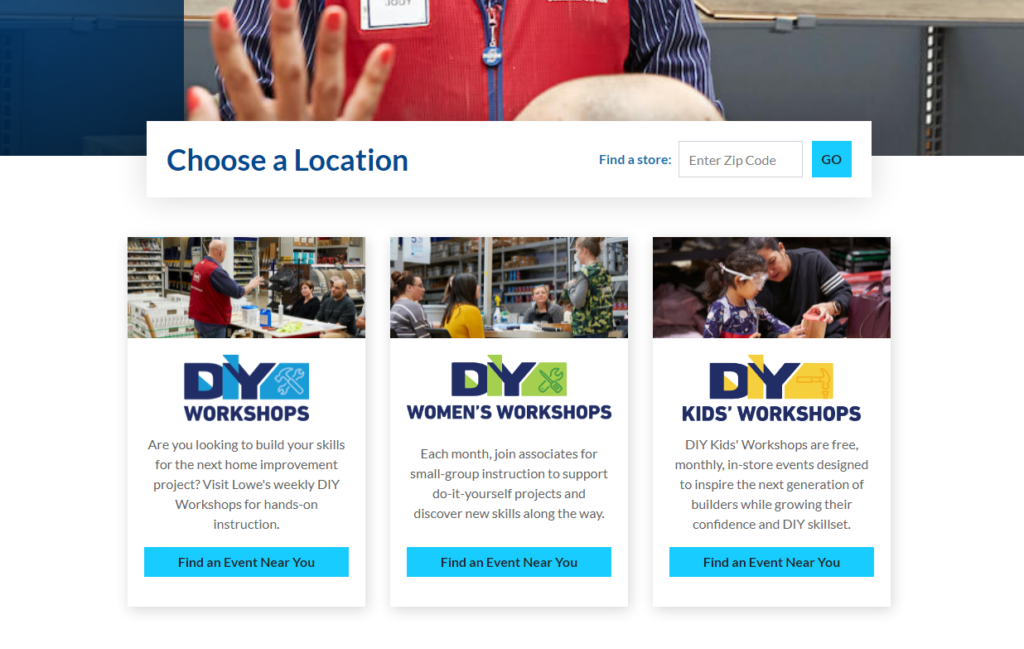
DIY how-to library
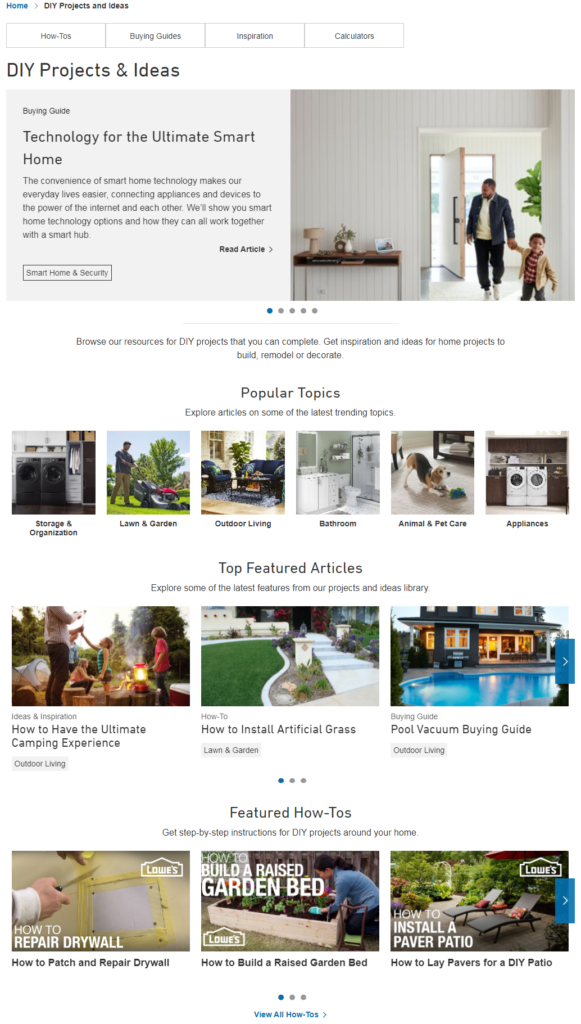
See the content focus?
These topics are oriented around the relative skill level of a DIYer and a typical project. The content is lighter in tone and designed to help homeowners learn entry-level skills.
What about pros?
Lowe’s for Pros
Lowe’s for Pros is focused on supporting professionals, giving them the tools, resources, and content they need to grow their business. Here’s a screenshot of their content category page.
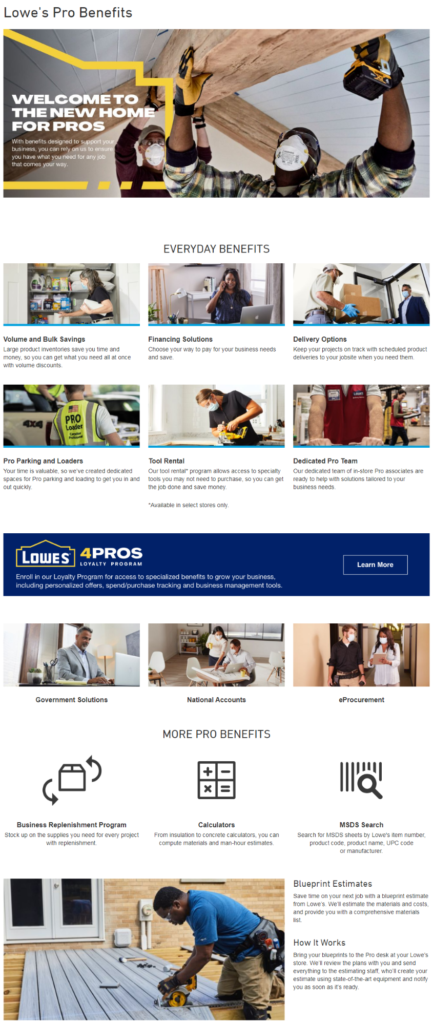
Lowe’s for Pros also has a variety of content that’s designed to serve the busy professional.
See the difference?
The content on their pro portal is designed to help professionals. The language, tone, topics, and projects are designed around two very different personas. What’s interesting about LOWE’s is the fact that they tie their products to specific projects listed in their content.
Their content and guides cover each phase of the buyer’s journey.
Let’s take a look at our next example.
IKEA
IKEA is famous for its ready to assemble furniture. IKEA is focused on two main buyer personas, their consumer and business personas.
IKEA for consumers
Their consumer websites focus on specific events like college furnishings, and the new school year or price-conscious customers interested in a good deal.
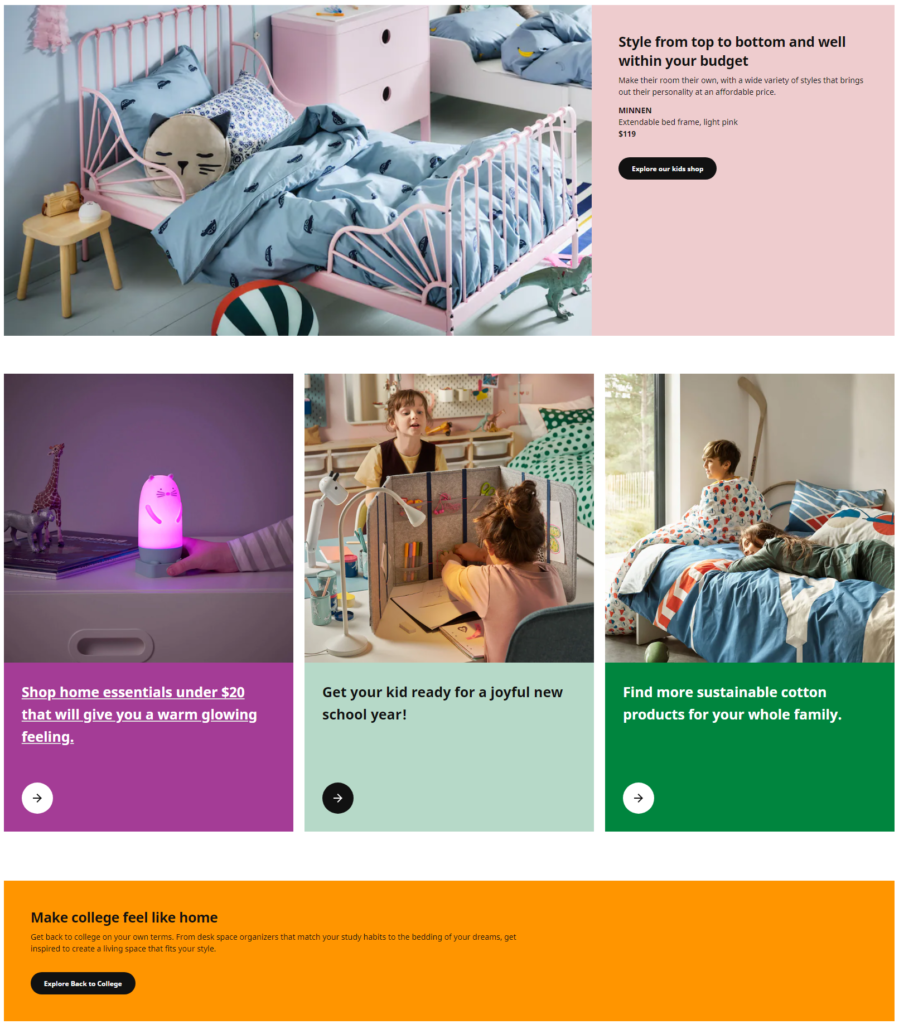
Contrast that with IKEA Business.
IKEA Business
IKEA for Business orients their content strategy around the needs of their buyer persona — planning an office, renewing office space, creating an ergonomic workspace. It’s helpful and focused on the needs of the business directly, rather than on various members of the family.

IKEA’s ToFu content focuses on high-level topics like renewing your office space, creating an ergonomic workspace, office planning, etc. But like LOWE’s, IKEA’s content guides customers through the buyer’s journey.
Their MoFu includes room showcases, and galleries content includes their room, table, and chair planner tools.

BoFu content includes an invitation to book an IKEA for Business virtual appointment
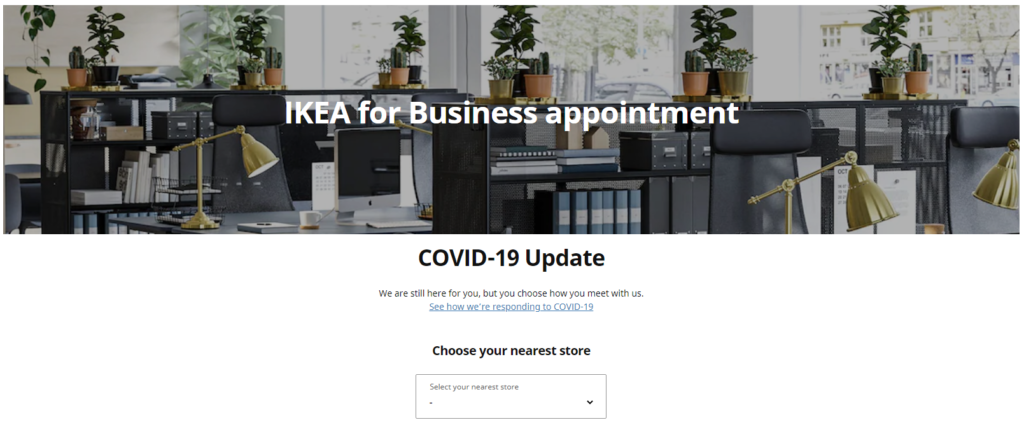
They create a maze of content that turns casual browsers into repeat shoppers.
Why you need to revisit your customer journey maps and content periodically
Customer behavior changes over time.
Sometimes these changes are drastic; other times, they’re incremental. COVID is a great example of how audiences have changed; customers are thinking and buying differently.
A recent report from McKinsey demonstrates this.
- The ecommerce industry saw a 10-years-in-8-weeks increase
- Ecommerce saw a 44% jump compared to 2019; the largest increase in over twenty years
- There’s been a 20x increase in remote work participants
- Disney Plus achieved in two months what it took Netflix 7 years to achieve
This change has shuffled customer behavior and habits dramatically. Thanks to COVID, consumers have covered a “decade in days” adoption of digital. Ecommerce has seen a meteoric rise as customers view home as “the new coffee shop, restaurant, and entertainment center.”
Here’s how COVID has restructured audience priorities.
- 17% of employees worked remotely pre-COVID, compared to 44% post-COVID
- E-commerce: 17-percentage-point increase in grocery, and a surge in e-pharmacy
- An increased consumer focus on health
- A 68% increase in limiting food waste
- 41% stated they would “only buy from brands I know and trust”
- Shopping more cost consciously
- Customers are shopping in closer neighborhood stores
The pandemic has shaken customer habits.
Customers are shopping locally and spending more money online. More people are working from home today than ever before. No one knows if the dramatic growth we’ve seen in the eCommerce industry is here to stay. Your content strategy should be informed by the changes we’ve seen.
If you have a content strategy in place, it’s worth revisiting it so you can make any necessary adjustments as the world opens up. In our IKEA example, they may find that customers aren’t as eager to go back to an in-store experience.
How an agency can help build out your content strategy using personas
This may not be something your organization wants to prioritize in-house. Maybe your team is focused on other important to-dos, or you’d like your content strategy to be crafted by seasoned professionals.
You may need an agency.
If you decide to go the agency route, you’ll want to ask questions about their process. Ideally, your agency will provide you with detailed recommendations and a comprehensive content strategy plan based on audience research.
Your agency should be able to:
- Share key components of their methodology with you
- Use customer data to create detailed user stories and characteristics
- Outline the buyer’s journey for individual personas
- Build a keyword list that’s oriented around buyer search activity
- Create content buckets and target options for each persona
- Craft your content strategy using the upfront analysis we’ve discussed
- Align your plan with your marketing channels and KPIs
- Track each customer from research to post-purchase
Each phase of the process should be clear and transparent. Your content strategy should align with your company’s goals and objectives.
Customers are the foundation of your marketing
Persona research is the key to understanding your customers. Successful brands need to customize their eCommerce content strategy, so it harmonizes with audience trends and the buyer’s journey. As customers become more familiar with your company, the buyer’s journey is easier.
Use personas as the basis of your content strategy.
With the right personas, you’ll be able to create a reliable content strategy that shepherds customers through the buyer’s journey, ensuring that you achieve and maintain the product/market fit your company needs to grow.
- The Cost of SEO Services in 2024 - January 4, 2024
- The 2024 SEO Guide To Successful Website Migration - April 4, 2023
- How Audience Research Shapes Financial Services Marketing - February 16, 2023
